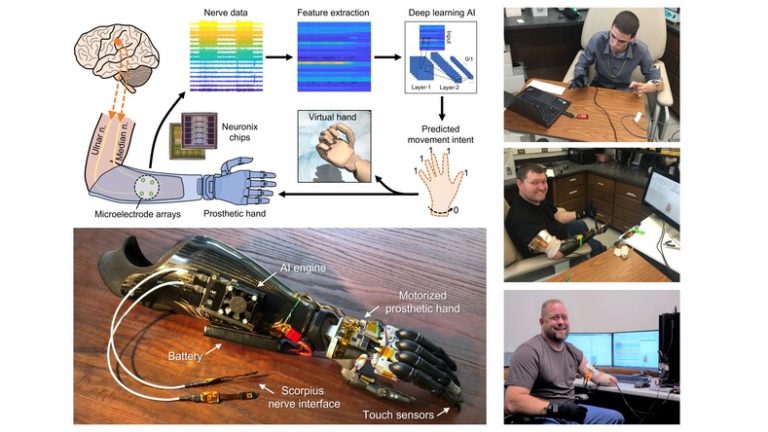The number of upper-limb amputees in the U.S. has been escalating during the past few decades and is expected to exceed 1 million by 2050. The next generation prosthetic hand that moves and feels like a real hand to significantly improve amputees’ well-being requires a robust neural interconnection between the human minds and machines.
This research presents a neuroprosthetic system to demonstrate that principle by employing an artificial intelligence (AI) agent to translate the amputee’s movement intent through a peripheral nerve interface. The AI agent is designed based on a recurrent neural network and could simultaneously decode six degree-of-freedom from multichannel nerve data in real-time. We characterize the decoder’s performance in motor decoding experiments with three human amputees.
First, we show that the AI agent enables amputees to intuitively control prosthetic hands with individual finger and wrist movements with up to 97-98% accuracy.
Second, we demonstrate the AI agent’s real-time performance by measuring the reaction time and information throughput in a hand gesture matching task. The task shows that the AI agent yields satisfying performance with a high success rate of over 99% for all gestures and a short reaction time of about 0.81 sec, leading to high information throughput of 365.4 bpm across different gestures.
Third, we investigate the AI agent performance in long-term uses. All experiments show no signs of deterioration in the signal strength and signal-to-noise ratio on 16 electrodes over the 16-month implantation. Moreover, thanks to the long implantation course, the subject has time to practice with the agent. Hence, there is a substantial reduction in the reaction time and an improvement in the success rate for all gestures over time. In addition, the success rate converges, which leads to the more consistent and accurate performance of all fingers.
Our study demonstrates the potential of AI-enabled nerve technology, underling the next generation of dexterous and intuitive prosthetic hands.

